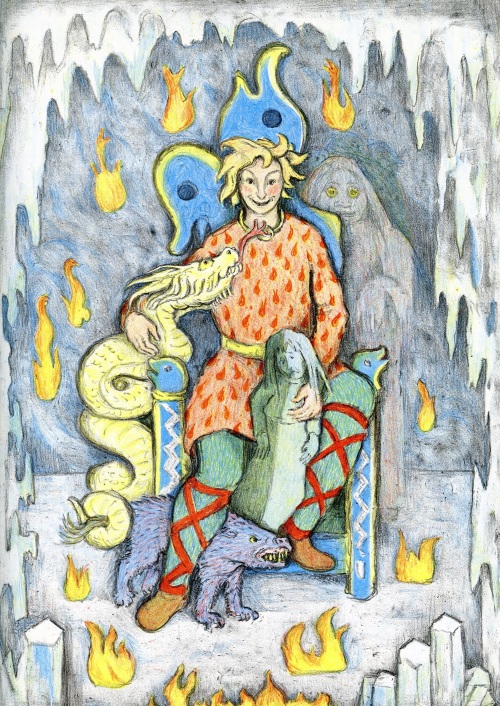
Clark
One Fish Two Fish Red Fish Blue Fish – Theodore Geisel
As I have been working on the illustrations for BOOM BOOM, I have been thinking about humor in children’s book illustrations – what amused me when I was a child and what I find funny now. I’m sure there is a common thread from one to the other, but I’m not going to delve too deeply. As E. B. White said, “Analyzing humor is like dissecting a frog. Few people are interested and the frog dies of it.”
Sometimes the images act as punch lines to the text, while in others the joke is delivered on a separate plate from the words. Many are visual puns. What I see as a constant is the amount of fun the illustrator appears to be having. In the best comedy for children, I believe joy, humor and art are a trio act, with joy having the leading role. Have you ever tried to illustrate a children’s book when you are not in a good mood? Unless you are drawing trolls or gargoyles, cheer up or take a break.
To demonstrate, I’ve put together a small collection of some of my favorites, old and new. I have no idea if the artists were grumbling or grinning when they worked on these books, but they must have been giggling at least a little by the time they were done.

The Ziffs on the cliffs and the Zuffs on the Bluffs
Scrambled Eggs Super – Theodore Geisel
Dr. Seuss tops the list. In my early reading years, the library my parents and I went to shelved their Seuss books on two conveniently low shelves. Scrambled Eggs Super was one that I picked up whenever it was available, regardless of how many times I’d checked it out already, and One Fish Two Fish Red Fish Blue Fish made learning to read worth the effort.

Here is what I have to do every French morning…
Eloise in Paris – Hilary knight

I am all over the Etoile…
Eloise in Paris – Hilary Knight
When I was about eight I discovered Eloise on a family road trip visiting friends of my mother’s in Vancouver, Canada. I slept in their daughter’s room. She was at least fifteen years older than I and long out of the house, but her collection of Eloise books by Kay Thompson, illustrated by Hilary Knight, were still there. I poured over Knight’s exuberant illustrations for hours. Eloise is truly all over the Etoile and all over the page. Her gestures and body language are as much choreographed as drawn.

He didn’t look where he was sitting…
The Story of Ferdinand – Robert Lawson
The Story of Ferdinand, the sensitive bull. While beautifully composed and exquisitely drafted, Robert Lawson‘s illustrations for Munro Leaf’s text are also wonderfully fun to look at.

The Outer Sanctum
The Bedside MAD – William M Gaines

The Outer Sanctum second spread
The Bedside MAD – William M Gaines
At about age nine, my taste in humor took a sidestep when I purchased some old MAD Magazine paperbacks. These books compiled early issues that featured artists like William M Gaines (also the magazine’s founder). He specialized in spoofing popular radio dramas from my father’s era such as “Inner Sanctum” with goofy yet surgical expertise. I think their intended audience probably wasn’t me, but take a close look at the details and you will see why I liked them so much as a nine-year-old.

I know an old lady who swallowed a bird
I Know an Old Lady-Abner Graboff
I didn’t discover the work of Abner Graboff until I found a copy of I Know An Old Lady by Rose Bonne at a school library sale a few years ago, but I wish I had found him sooner. Thank you, Abner, for breaking all the rules.
And lest you have the impression that I only look at children’s books published before 1960, here are a few more contemporary works that make me laugh.

Arnie looked around and saw all sorts of doughnuts…
Arnie the Doughnut – Laurie Keller
Laurie Keller is funny, in both text and imagery (And in person too. I was lucky enough to meet her). She could make a stand-up comic out of a golf ball.

Ed
Polka Bats and Octopus Slacks – Calef Brown
This image by Calef Brown is wonderful even without the poem that accompanies it (sorry, you will have to go get the book yourself and read it). Which came first, the image or the words? Who cares. I’m glad for both.

The Walking Stick
Insectlopedia – Douglas Florian
Douglas Florian is a poet who is also an artist. Or maybe he is an artist who is also a poet. Either way, he creates books with a graceful blend of sophistication and whimsy (sorry, you are going to have to go get this book too). His humor is subtle and precise and beautifully rendered.

…potatoes however…
Glasses, Who Needs ‘Em? – Lane Smith
And Lane Smith. Smith has made numerous hilarious books, but I think I like this image from Glasses, Who Needs ‘Em? best of all. Do you see what I mean?…
I hope this small sampling has made you laugh, tickled your funny bone, or at least improved your mood. If you are going to be illustrating children’s books, you might as well be smiling, right?



























